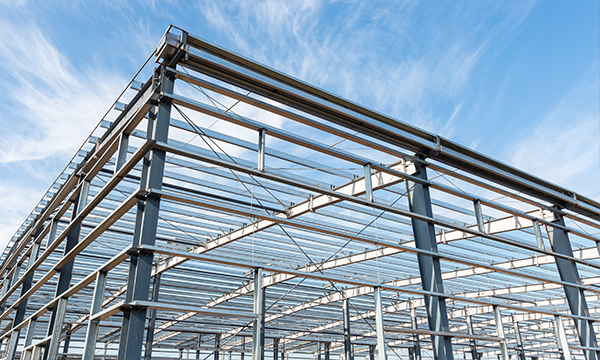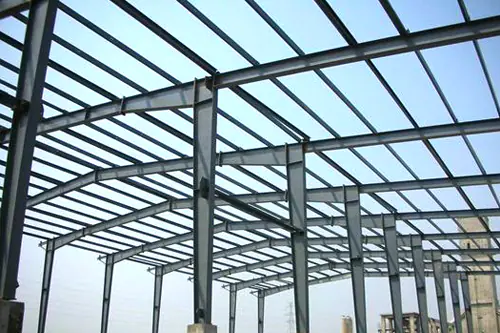Steel Structures for Commercial Buildings: A Modern and Efficient Solution
Need a strong, quickly constructed, and environmentally friendly commercial building? Steel structures are the answer. Learn about the benefits and construction process in the following article.
Steel structures have become a popular choice for modern commercial buildings. With advantages in strength, speed of construction, flexibility, and sustainability, steel structures offer optimal solutions for various types of commercial buildings.
From office buildings to shopping centres, steel structures can meet the functional and aesthetic needs of your project.
1. Summary of Steel Structures for Commercial Buildings
Steel structures have become a primary choice in modern commercial building construction. Compared to traditional materials like concrete, steel structures offer several significant advantages. Steel buildings consist of steel components assembled to form the building’s framework. These components include columns, beams, and roof frames.
One of the main factors driving the popularity of steel structures is the speed of construction. Steel components can be mass-produced in factories, drastically reducing construction time on project sites. Additionally, the lightweight nature of steel structures allows for the use of smaller foundations, saving time and construction costs.
Steel structures are also known for their design flexibility. Architects have greater creative freedom in designing the shape and size of buildings without being limited by the constraints of other materials. Design changes can also be made more easily during the construction phase.
Furthermore, steel structures offer exceptional resistance to various extreme weather conditions such as earthquakes, hurricanes, and fires. The high tensile and compressive strength of steel ensures the building remains stable and safe in emergency situations.
From an aesthetic standpoint, steel structures also provide attractive options. With technological advancements, various types of coatings and finishes can be applied to steel components to create a modern and elegant appearance.

2. Advantages of Steel Structures for Commercial Buildings
Steel structures offer several significant advantages over traditional building materials. One of the main benefits is their extraordinary strength and durability. Steel has high tensile and compressive strength, enabling it to withstand heavy loads and extreme weather conditions like earthquakes, hurricanes, and storms. This ensures the safety and longevity of commercial buildings.
In addition to strength, steel structures are also known for their fire resistance. Steel has a high melting point, allowing it to withstand high temperatures during fires longer than other materials. This provides more time for evacuation and firefighting efforts.
The speed of construction is another significant advantage of steel structures. Steel components can be mass-produced in factories, drastically reducing on-site construction time. This process also allows for other preparatory work, such as utility installations and interior finishing, to be done in parallel, accelerating the overall project timeline.
Design flexibility is another important aspect of steel structures. This material allows architects to create various building shapes and sizes without the limitations of other materials. Design changes can also be made more easily during the construction phase.
In addition to strength, speed, and flexibility, steel structures also offer cost efficiency. Although the initial cost of steel materials may be higher than some alternatives, the overall project cost is often lower. Reduced construction time, smaller foundations, and labor efficiency contribute to cost savings.
Steel structures also have a lower environmental impact compared to some other building materials. Steel is a fully recyclable material, reducing construction waste. Additionally, steel buildings have a long lifespan, reducing the need for rebuilding and generating new waste.
In terms of maintenance, steel structures are relatively easy to maintain. Protective coatings applied to steel components help prevent corrosion. Routine inspections and simple maintenance can ensure the longevity of the building.

3. Types of Steel Structures for Commercial Buildings
Steel structures can be categorised based on various factors, including the type of steel profile, construction system, and building application. Some common types of steel structures used in commercial buildings include:
- Shaped Steel Structures: Using standard steel profiles such as H-beams, I-beams, and channels to form the building framework. This type is highly flexible and can be used for various types of commercial buildings.
- Light Steel Structures: Using thin, high-strength steel profiles to reduce the weight of the structure. Suitable for low-rise commercial buildings such as warehouses, factories, and showrooms.
- Prefabricated Steel Structures: Using steel components manufactured in factories and assembled on the project site. This type offers high construction speed and accuracy.
- Composite Steel Structures: Combining steel with other materials such as concrete to enhance strength and stiffness. Often used for floors and roofs of commercial buildings.

4. Construction of Commercial Buildings with Steel Structures
Building steel structures involves several main stages. The process begins with planning and designing the building by architects and structural engineers. This stage includes determining dimensions, structural loads, and utility systems.
Once the design is complete, steel components are mass-produced in factories. This process involves cutting, welding, and coating to ensure the quality and durability of the components.
The next stage is transporting the steel components to the project site. These components are then assembled by the construction team using cranes and other heavy equipment. The assembly process is relatively quick compared to construction using traditional materials.
After the main steel structure is completed, facade installation, roofing, and utility systems can be done in parallel, increasing construction time efficiency.
The final stage involves interior finishing work, such as installing floors, ceilings, partitions, and lighting systems.

5. Challenges and Considerations for Commercial Steel Buildings
Although steel structures offer many advantages, there are several challenges and considerations in building commercial buildings with steel structures. One of the main challenges is handling and installing heavy steel components. Special equipment and trained labor are required to carry out this process safely and efficiently.
Fire protection is also an important aspect of steel building construction. Although steel has good fire resistance, additional measures such as fire-resistant coatings and sprinkler systems are necessary to ensure occupant safety.
Additionally, thermal insulation is a factor that needs consideration. Steel structures have high thermal conductivity, requiring adequate insulation to maintain comfortable indoor temperatures.
Corrosion prevention is also crucial to ensure the longevity of steel structures. Protective coatings such as paint or galvanization must be applied correctly to prevent damage from corrosion.
Besides the mentioned challenges, cost control is another important aspect. Although steel structures offer long-term cost efficiency, it is important to plan and manage the budget well. Factors such as material selection, optimal design, and effective project management can help control costs.
Noise pollution is also a consideration in constructing commercial buildings using steel structures. Mitigation measures such as using sound dampers and acoustic insulation can help reduce noise impact.
Finally, it is important to consider the aesthetic aspect of the building. Although steel structures offer design flexibility, it is necessary to consider how to integrate steel structures with other design elements to create an attractive appearance that meets the building’s needs.
6. Conclusion
Steel structures have become a popular choice for modern commercial buildings due to their advantages in strength, speed of construction, flexibility, and cost efficiency. Although there are some challenges, such as handling heavy materials, fire protection, and thermal insulation, proper measures can address these issues.
With careful planning, appropriate material selection, and the use of the latest technology, steel structures can be an optimal solution for various types of commercial buildings. It is important to consider factors such as cost, aesthetics, and environmental impact in the decision-making process.
With the continuous advancement of technology and growing awareness of sustainability, the future of steel structures looks promising. The increasing efficiency and environmental friendliness of steel will continue to drive the growth of the construction industry using this material.

Post Comment